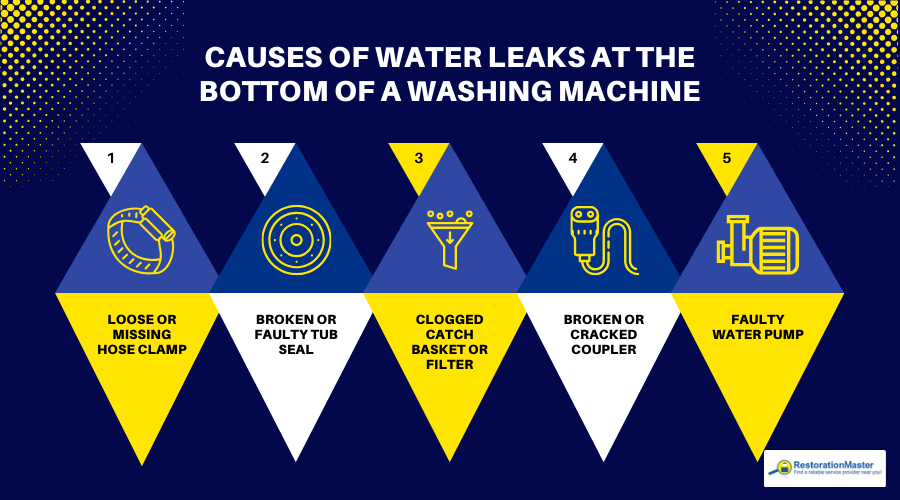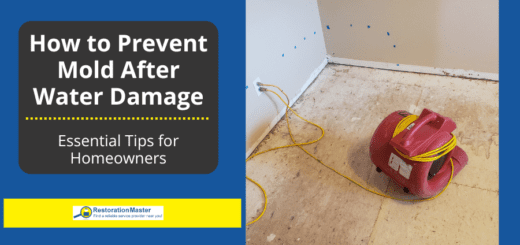Water Leaking From the Bottom of Your Washer? Where to Look
Water leaking from the bottom of a washer can quickly turn a routine laundry day into a frustrating ordeal. Not only does it disrupt your household chores, but it also poses a significant risk of water damage to your home. Additionally, newer washing machines are so complicated to fix, that you may feel hopeless trying to find the source of a leak.
To prevent potential structural damage, mold growth, and costly repairs, it is important to promptly address a leak, no matter how big or small. Understanding the common causes behind this leak and where to look can help you identify the source of the leakage.

Signs of a Washer Leaking from the Bottom
Water appearing around your washing machine can be overwhelming and stressful. When trying to identify if a water leak is coming from the bottom of a washing machine, look for these signs:
- Water accumulation beneath the washing machine
- Dirty water leaking from the machine during the wash cycle
- A damp or musty smell around the washer
- Wet or soggy flooring around the washing machine
- Signs of water damage, such as visible stains or warped floorboards.
What Causes Water to Leak Under a Washing Machine?
When water leaks from the bottom of a washing machine, it often signals a problem that needs immediate attention. These leaks can start as minor drips but can quickly escalate into larger problems, leading to water damage, moldMold is a type of fungus that grows in damp or humid conditi... More growth, and expensive repairs if not addressed promptly. This problem can arise from several underlying causes, each with its own set of challenges.
In this section, we will explore the most common causes of washing machine leaks, helping you identify and address the problem before it becomes a more serious concern.

A Loose or Missing Hose Clamp
The drain hose of your washing machine should be fitted securely to the drainage pipe extending out of your washer. You should see a clamp for the hose connection where the drainage pipe and drainage hose meet. Although some models may have this clamp on the interior, it should be easy to identify on most models.
If the connection seems loose or visibly unsecured, or if there’s no clamp or sealed connection in place, this could be the reason water is leaking from the bottom of the washer. In some cases, you can simply hand-tighten the water hose. But other times you may need a replacement part or professional serviceman to do the job.
Broken or Faulty Tub Seal
If the water leak is coming from underneath the washer, replacing the tub seal often resolves the issue, especially if the leak occurs during the rinse cycle. The tub seal is located at the top of the washing machine’s transmission, requiring you to remove the spin basket and possibly flip the washer over to access it.
Checking or replacing your washing machine’s tub seal often includes extensive disassembly. It is suggested for homeowners to call a professional repairman for assistance.
A Clogged Catch Basket or Filter
The catch basket in a washing machine is very similar to a lint trap in your dryer. Over time, it can become clogged and cause fibers to appear in your washed laundry and cause the washer to leak from the bottom.
You can find the catch basket either along the top edge of the washing machine’s drum, the top of the center column (called the agitator) of the drum, or at the end of the drain hose where there may be a removable screen you can clean. If you have a newer washing machine, you may not have these catch baskets.
A Broken or Cracked Coupler
The coupler is a seal, often made of plastic or rubber, between the motor and the drum of the washing machine. The purpose of a coupler is to break in the event of a malfunction to save the actual machinery and it is a lot cheaper to replace!
If you notice your washing machine is not spinning properly in addition to the leaks, a broken coupler is likely the culprit.
A Faulty Water Pump
Leaks under the washer are commonly caused by a damaged water pump or compromised hoses connected to the pump. If the water leak is caused by a faulty water pump, you may notice incomplete drainage, unusual noises, and rumbling in addition to the water leak. The water pump in a washer is most commonly located at the bottom of the machine. You can identify the water pump by the two large hoses connected to it.
By identifying these connections, you can visually identify if they are loose or clogged.
What to Do if Your Washing Machine is Leaking From the Bottom
Washing machines can leak gallons of water at a time, often occurring overnight or going unnoticed for hours. The water damage this can cause is substantial. If not promptly addressed, the water leak may call for extensive repairs to flooring and drywall in the future.
Never take a chance with water damage. Locate a water damage restoration company near you as soon as possible. While a flood cleanup technician is on his way, examine the aforementioned parts of your washer as best you can.
If you locate what’s causing the leak from the bottom of your washer beforehand, this can speed up the water restorationRestoration is the process of returning a property to its pr... More process considerably.
A good water damage restorationWater damage restoration is the professional process of clea... More service will immediately extract the water that flooded from the washing machine. They will then set up dehumidificationDehumidification is the process of reducing and controlling ... More equipment to dry out the area as quickly as possible.

Perhaps most importantly, a water mitigation crew will also apply mold remediation methods to prevent any growths from occurring near your washing machine.
Leaks from the bottom of a washing machine are a major headache and a common cause of major water damage. Check for the source of the leak and get water restorationRestoration is the process of returning a property to its pr... More professionals on-site as soon as you can.












